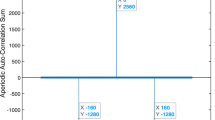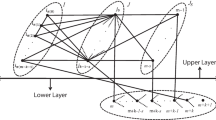Abstract
Boolean functions naturally induce binary sequences of length \(2^m\) and a large number of such orthogonal sequences is required in the design of code-division multiple-access (CDMA) systems. In this paper, Boolean functions are used to construct nonlinear phase orthogonal sequence sets for CDMA communications. For even m, employing carefully designed an m-variable Boolean function with five-valued Walsh spectra, one can get 16 different orthogonal sequence sets with sequence length \(2^m\). These sequence sets are assigned to a lattice of regular hexagonal cells, and we can ensure the orthogonality of adjacent cells. Moreover, the cross-correlation values between the sequences in a given cell and the sequences in non-neighbouring cells belong to \(\{0,\pm 2^{\frac{m}{2}}, \pm 2^{\frac{m}{2}+1}\}\). On the other hand, the cardinality of the sequences sets is \(2^{m-3}\) thus implying a trade-off between the quality of communication and the number of users assigned to each cell. This method can be improved so that the number of users is increased to \(2^{m-2}\) in one half of the network while preserving the orthogonality between adjacent cells and the same level of low cross-correlation values to the non-neighbouring cells.



Similar content being viewed by others
Data availability
All data generated or analysed during this study are included in this published article.
References
Hunt F.H., Smith D.H.: The construction of orthogonal variable spreading factor codes from semi-bent functions. IEEE Trans. Wirel. Commun. 11, 2970–2975 (2012).
MacWilliams F.J., Sloane N.J.A.: The Theory of Error-Correcting Codes. North-Holland, Amsterdam (1977).
Rothaus O.S.: On bent functions. J. Comb. Theory 20, 300–305 (1976).
Smith D.H., Ward R.P., Perkins S.: Gold codes, Hadamard partitions and the security of CDMA systems. Des. Codes Cryptogr. 51, 231–243 (2009).
Smith D.H., Hunt F.H., Perkins S.: Exploiting spatial separations in CDMA systems with correlation constrained sets of Hadamard matrices. IEEE Trans. Inf. Theory 56, 5757–5761 (2010).
Tang X., Mow W.H.: Design of spreading codes for quasi-synchronous CDMA with intercell interference. IEEE J. Sel. Areas Commun. 24, 84–93 (2006).
Walsh J.L.: A closed set of normal orthogonal functions. Am. J. Math. 45, 5–24 (1923).
Yang K., Kim Y.-K., Kumar P.V.: Quasi-orthogonal sequences for code-division multiple-access systems. IEEE Trans. Inf. Theory 46, 982–993 (2000).
Ye Z.F., Zhou Z.C., Lei X.F., Fan P.Z., Liu Z.L., Tang X.H.: Low ambiguity zone: theoretical bounds and Doppler-resilient sequence design in integrated sensing and communication systems. IEEE J. Sel. Areas Commun. 40, 1809–1822 (2022).
Zhang W.-G., Pasalic E.: Generalized Maiorana-McFarland construction of resilient Boolean functions with high nonlinearity and good algebraic properties. IEEE Trans. Inf. Theory 60, 6681–6695 (2014).
Zhang W.-G., Xie C.-L., Pasalic E.: Large sets of orthogonal sequences suitable for applications in CDMA systems. IEEE Trans. Inf. Theory 62, 3757–3767 (2016).
Zhang W.-G., Pasalic E., Zhang L.-P.: Phase orthogonal sequence sets for (QS)CDMA communications. Des. Codes Cryptogr. 9, 1139–1156 (2022).
Zhou Z.C., Helleseth T., Udaya P.: A family of polyphase sequences with asymptotically optimal correlation. IEEE Trans. Inf. Theory 64, 2896–2900 (2018).
Zhou Z.C., Zhang D., Helleseth T., Wen J.M.: A construction of multiple optimal ZCZ sequence sets with good cross-correlation. IEEE Trans. Inf. Theory 64(2), 1340–1346 (2018).
Acknowledgements
WeiGuo Zhang is partly supported by the National Natural Science Foundation of China (Grant 61972303, 62272360). Enes Pasalic is partly supported by the Slovenian Research Agency (research program P1-0404 and research projects J1-9108, J1-1694).
Author information
Authors and Affiliations
Corresponding author
Additional information
Communicated by K.-U. Schmidt.
Publisher's Note
Springer Nature remains neutral with regard to jurisdictional claims in published maps and institutional affiliations.
Appendix
Appendix
The sets of orthogonal sequences \(H_{000}\), \(H_{001}\), \(\ldots \), \(H_{111}\) in Example 1 is given as below:
\(H_{000}\):
(++++++++++++++++++++++++++++++++++++++++++++++++++++++++++++++++)
(++++++++——–++++++++——–++++++++——–++++++++——–)
(++++++++++++++++—————-++++++++++++++++—————-)
(++++++++—————-++++++++++++++++—————-++++++++)
(++++++++++++++++++++++++++++++++——————————–)
(++++++++——–++++++++—————-++++++++——–++++++++)
(++++++++++++++++——————————–++++++++++++++++)
(++++++++—————-++++++++——–++++++++++++++++——–)
\(H_{001}\):
(+-+-+-+-+-+-+-+-+-+-+-+-+-+-+-+-+-+-+-+-+-+-+-+-+-+-+-+-+-+-+-+-)
(+-+-+-+–+-+-+-++-+-+-+–+-+-+-++-+-+-+–+-+-+-++-+-+-+–+-+-+-+)
(+-+-+-+-+-+-+-+–+-+-+-+-+-+-+-++-+-+-+-+-+-+-+–+-+-+-+-+-+-+-+)
(+-+-+-+–+-+-+-+-+-+-+-++-+-+-+-+-+-+-+–+-+-+-+-+-+-+-++-+-+-+-)
(+-+-+-+-+-+-+-+-+-+-+-+-+-+-+-+–+-+-+-+-+-+-+-+-+-+-+-+-+-+-+-+)
(+-+-+-+–+-+-+-++-+-+-+–+-+-+-+-+-+-+-++-+-+-+–+-+-+-++-+-+-+-)
(+-+-+-+-+-+-+-+–+-+-+-+-+-+-+-+-+-+-+-+-+-+-+-++-+-+-+-+-+-+-+-)
(+-+-+-+–+-+-+-+-+-+-+-++-+-+-+–+-+-+-++-+-+-+-+-+-+-+–+-+-+-+)
\(H_{010}\):
(++–++–++–++–++–++–++–++–++–++–++–++–++–++–++–++–)
(++–++—-++–++++–++—-++–++++–++—-++–++++–++—-++–++)
(++–++–++–++—-++–++–++–++++–++–++–++—-++–++–++–++)
(++–++—-++–++–++–++++–++–++–++—-++–++–++–++++–++–)
(++–++–++–++–++–++–++–++—-++–++–++–++–++–++–++–++)
(++–++—-++–++++–++—-++–++–++–++++–++—-++–++++–++–)
(++–++–++–++—-++–++–++–++–++–++–++–++++–++–++–++–)
(++–++—-++–++–++–++++–++—-++–++++–++–++–++—-++–++)
\(H_{011}\):
(+–++–++–++–++–++–++–++–++–++–++–++–++–++–++–++–+)
(+–++–+-++–++-+–++–+-++–++-+–++–+-++–++-+–++–+-++–++-)
(+–++–++–++–+-++–++–++–++-+–++–++–++–+-++–++–++–++-)
(+–++–+-++–++–++–++-+–++–++–++–+-++–++–++–++-+–++–+)
(+–++–++–++–++–++–++–++–+-++–++–++–++–++–++–++–++-)
(+–++–+-++–++-+–++–+-++–++–++–++-+–++–+-++–++-+–++–+)
(+–++–++–++–+-++–++–++–++–++–++–++–++-+–++–++–++–+)
(+–++–+-++–++–++–++-+–++–+-++–++-+–++–++–++–+-++–++-)
\(H_{100}\):
(++++—-++++—-++++—-++++—-++++—-++++—-++++—-++++—-)
(++++——–++++++++——–++++++++——–++++++++——–++++)
(++++—-++++——–++++—-++++++++—-++++——–++++—-++++)
(++++——–++++—-++++++++—-++++——–++++—-++++++++—-)
(++++—-++++—-++++—-++++——–++++—-++++—-++++—-++++)
(++++——–++++++++——–++++—-++++++++——–++++++++—-)
(++++—-++++——–++++—-++++—-++++—-++++++++—-++++—-)
(++++——–++++—-++++++++——–++++++++—-++++——–++++)
\(H_{101}\):
(+-+–+-++-+–+-++-+–+-++-+–+-++-+–+-++-+–+-++-+–+-++-+–+-+)
(+-+–+-+-+-++-+-+-+–+-+-+-++-+-+-+–+-+-+-++-+-+-+–+-+-+-++-+-)
(+-+–+-++-+–+-+-+-++-+–+-++-+-+-+–+-++-+–+-+-+-++-+–+-++-+-)
(+-+–+-+-+-++-+–+-++-+-+-+–+-++-+–+-+-+-++-+–+-++-+-+-+–+-+)
(+-+–+-++-+–+-++-+–+-++-+–+-+-+-++-+–+-++-+–+-++-+–+-++-+-)
(+-+–+-+-+-++-+-+-+–+-+-+-++-+–+-++-+-+-+–+-+-+-++-+-+-+–+-+)
(+-+–+-++-+–+-+-+-++-+–+-++-+–+-++-+–+-++-+-+-+–+-++-+–+-+)
(+-+–+-+-+-++-+–+-++-+-+-+–+-+-+-++-+-+-+–+-++-+–+-+-+-++-+-)
\(H_{110}\):
(++—-++++—-++++—-++++—-++++—-++++—-++++—-++++—-++)
(++—-++–++++–++—-++–++++–++—-++–++++–++—-++–++++–)
(++—-++++—-++–++++—-++++–++—-++++—-++–++++—-++++–)
(++—-++–++++—-++++–++—-++++—-++–++++—-++++–++—-++)
(++—-++++—-++++—-++++—-++–++++—-++++—-++++—-++++–)
(++—-++–++++–++—-++–++++—-++++–++—-++–++++–++—-++)
(++—-++++—-++–++++—-++++—-++++—-++++–++—-++++—-++)
(++—-++–++++—-++++–++—-++–++++–++—-++++—-++–++++–)
\(H_{111}\):
(+–+-++-+–+-++-+–+-++-+–+-++-+–+-++-+–+-++-+–+-++-+–+-++-)
(+–+-++–++-+–++–+-++–++-+–++–+-++–++-+–++–+-++–++-+–+)
(+–+-++-+–+-++–++-+–+-++-+–++–+-++-+–+-++–++-+–+-++-+–+)
(+–+-++–++-+–+-++-+–++–+-++-+–+-++–++-+–+-++-+–++–+-++-)
(+–+-++-+–+-++-+–+-++-+–+-++–++-+–+-++-+–+-++-+–+-++-+–+)
(+–+-++–++-+–++–+-++–++-+–+-++-+–++–+-++–++-+–++–+-++-)
(+–+-++-+–+-++–++-+–+-++-+–+-++-+–+-++-+–++–+-++-+–+-++-)
(+–+-++–++-+–+-++-+–++–+-++–++-+–++–+-++-+–+-++–++-+–+)
Rights and permissions
Springer Nature or its licensor holds exclusive rights to this article under a publishing agreement with the author(s) or other rightsholder(s); author self-archiving of the accepted manuscript version of this article is solely governed by the terms of such publishing agreement and applicable law.
About this article
Cite this article
Zhang, W., Pasalic, E., Liu, Y. et al. A design and flexible assignment of orthogonal binary sequence sets for (QS)-CDMA systems. Des. Codes Cryptogr. 91, 373–389 (2023). https://doi.org/10.1007/s10623-022-01113-4
Received:
Revised:
Accepted:
Published:
Issue Date:
DOI: https://doi.org/10.1007/s10623-022-01113-4




